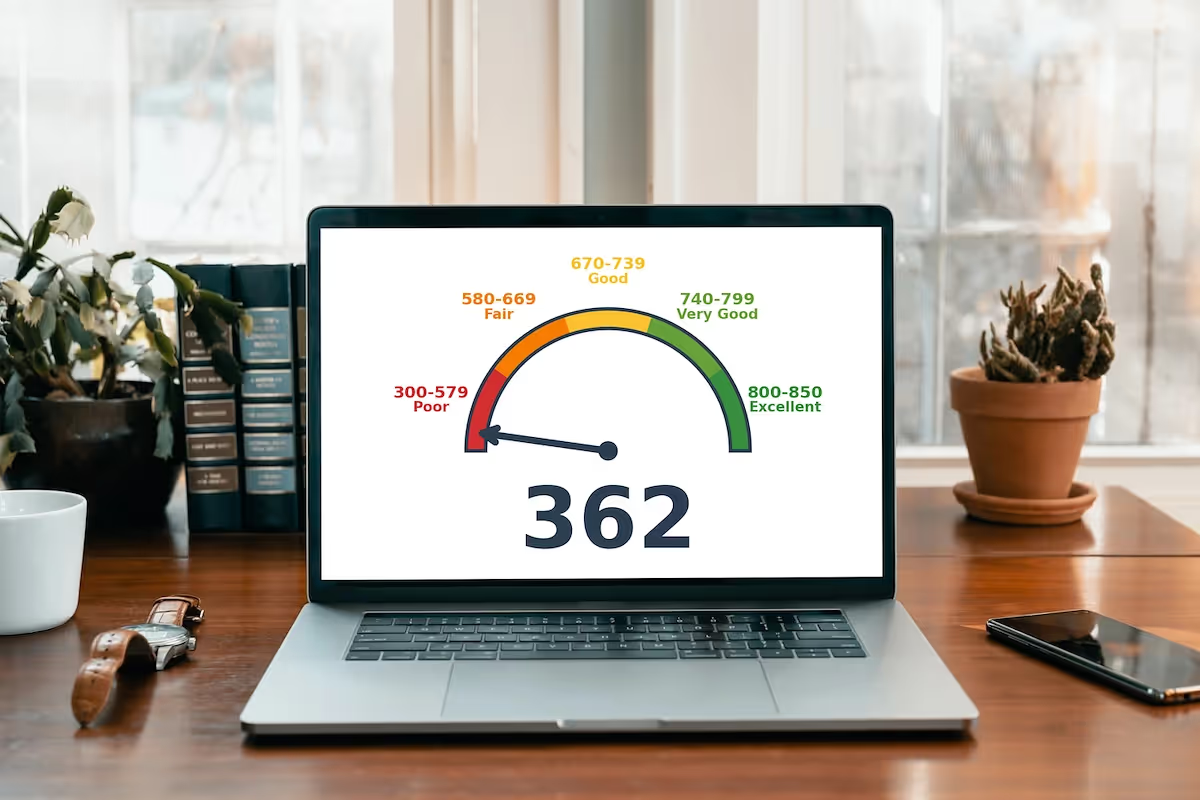
Kudos has partnered with CardRatings and Red Ventures for our coverage of credit card products. Kudos, CardRatings, and Red Ventures may receive a commission from card issuers. Kudos may receive commission from card issuers. Some of the card offers that appear on Kudos are from advertisers and may impact how and where card products appear on the site. Kudos tries to include as many card companies and offers as we are aware of, including offers from issuers that don't pay us, but we may not cover all card companies or all available card offers. You don't have to use our links, but we're grateful when you do!
362 Credit score: What You Need to Know in 2025
July 1, 2025


TL;DR
A 362 credit score is a foundational starting point, offering a clear path for financial improvement. This score falls within the 'Poor' FICO range, marking the beginning of your journey toward building a stronger credit profile.
What Does a 362 Credit Score Mean?
A credit score of 362 is considered "poor" on the FICO Score scale, which ranges from 300 to 850. This number suggests a history of significant financial missteps, such as serious delinquencies or collections. Lenders see this score as a major red flag, making it extremely difficult to get approved for new lines of credit.
With a 362 score, your financial options are severely restricted. Mainstream lenders will likely deny applications for mortgages, auto loans, and credit cards. Any credit you do qualify for will come with very high interest rates and poor terms, making borrowing expensive. While this presents a major challenge, credit scores are dynamic and can be improved over time.
Who Has a 362 Credit Score?
While age isn't a direct factor in credit scoring, there is a clear trend of scores increasing over time as people build longer credit histories. According to 2023 Experian data, here are the average FICO scores by generation:
- Generation Z (ages 18-26): 680
- Millennials (ages 27-42): 690
- Generation X (ages 43-58): 709
- Baby Boomers (ages 59-77): 745
- Silent Generation (ages 78+): 760
Credit Cards With a 362 Credit Score
A credit score of 362 falls into the 'very poor' range, which can significantly hinder your ability to obtain a credit card. Lenders view this score as a high-risk indicator, making them reluctant to approve you for traditional, unsecured credit cards. Consequently, your options will likely be limited to products specifically designed for building credit, such as secured credit cards that require a cash deposit.
Kudos' AI-powered tools, like the Explore Tool, help you find a card by matching your stated preferences against a database of nearly 3,000 options. The Dream Wallet feature further personalizes this by analyzing your spending habits and providing insights into how a new card might impact your credit score.
Auto Loans and a 362 Credit Score
A 362 credit score places you in the deep subprime category, which can make securing an auto loan challenging, though not impossible. Lenders will view you as a high-risk borrower, meaning you'll likely face some of the highest interest rates and strictest loan terms available.
According to a 2025 market analysis, average auto loan rates break down as follows across the different credit score tiers:
- Super-prime (781-850): 5.25% for new cars, 7.13% for used cars
- Prime (661-780): 6.87% for new cars, 9.36% for used cars
- Non-prime (601-660): 9.83% for new cars, 13.92% for used cars
- Subprime (501-600): 13.18% for new cars, 18.86% for used cars
- Deep subprime (300-500): 15.77% for new cars, 21.55% for used cars
Mortgages at a 362 Credit Score
With a 362 credit score, qualifying for a traditional mortgage is unfortunately not possible. According to current mortgage requirements, even the most lenient government-backed programs have higher minimums. For instance, an FHA loan requires a score of at least 500, while conventional loans typically start at 620. Lenders view scores this low as extremely high-risk, meaning traditional financing options are essentially unavailable until the score is improved.
In the rare event a specialty or subprime lender considered an application, the impact on the loan would be severe. You would face substantially higher interest rates, steep fees, and a large down payment requirement. Lenders would also likely cap the loan amount, limiting your purchasing power, and subject your entire financial history to intense scrutiny through a manual underwriting process. In practice, very few mortgages are approved for scores below 600.
What's in a Credit Score?
Understanding your credit score can feel like trying to solve a complex puzzle, as it's a blend of several key financial habits. The most common factors that determine your score include:
- Your payment history tracks whether you have paid past credit accounts on time.
- Credit utilization is the percentage of your available credit that you are currently using.
- The length of your credit history considers the age of your oldest account and the average age of all your accounts.
- Credit mix refers to the variety of credit products you have, such as credit cards, retail accounts, and loans.
- New credit inquiries and recently opened accounts can also temporarily impact your score.
How to Improve Your 362 Credit Score
Your credit score plays a crucial role in your financial life, but a low score isn't a permanent setback. With consistent positive behavior, it is possible to improve your creditworthiness using proven methods and see meaningful changes over time.
- Monitor your credit reports regularly. A score as low as 362 could be weighed down by errors, and checking your reports allows you to find and dispute these inaccuracies. This also helps you track your progress as you begin the journey of rebuilding your credit.
- Establish automatic bill payments. Since payment history is the most significant factor in your score, establishing a record of on-time payments is the most critical first step. Automating payments helps you avoid late or missed payments, which are especially damaging when trying to recover from a very low score.
- Apply for a secured credit card. For those with damaged credit, a secured card is an essential tool for building a new, positive payment history. By using it responsibly, you demonstrate to lenders that you can manage credit, which is vital for improving your score.
- Address collection accounts. Accounts in collections have a severe negative impact on your credit, and they must be addressed proactively. Negotiating a settlement or payment plan can help reduce their long-term damage and show lenders you are taking responsibility for your debts.
For more tools to help manage your cards and improve your score, consider using the resources offered by Kudos.
Unlock your extra benefits when you become a Kudos member

Turn your online shopping into even more rewards

Join over 400,000 members simplifying their finances

Editorial Disclosure: Opinions expressed here are those of Kudos alone, not those of any bank, credit card issuer, hotel, airline, or other entity. This content has not been reviewed, approved or otherwise endorsed by any of the entities included within the post.



































.webp)



.webp)

.webp)


